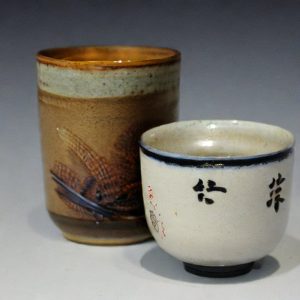
Yunomi (湯呑) literally means “hot water drinking”.
It’s an abbreviation of yunomi jawan (湯吞茶碗), where the word chawan means “tea bowl”.
Note that in Japan, the word chawan used by itself usually refers to the “rice bowl”. In other words, it’s for eating instead of drinking.
As for the matcha bowl, it is called matcha tea bowl (抹茶茶碗, maccha jawan). But it’s usually shortened as maccha wan.
The yunomi teacup is different from the matcha bowl because it isn’t as wide.
History of the Yunomi
Since tea came to Japan from China, it makes sense that teaware in Japan has the same origin.
The yunomi as a teacup for drinking teas like sencha (as opposed to matcha), became common from the Edo period (1603 and 1867) onward.
It’s fairly recent.
Unsurprisingly, senchado (the sencha ceremony) and sencha as a type of tea itself were invented during this period.
Types of Yunomi
The most common type of yunomi is the one with a tall and cylindrical shape.
It’s specifically called nagayunomi (長湯呑), but it’s so popular that people just call it yunomi.
This shape is often used for teas such as bancha, genmaicha and houjicha, and you’ve probably seen it at a sushi bar.
Another type of yunomi is short and wide, the kumidashi yunomi (汲み出し湯呑). It’s also called kumidashi jawan (汲出し茶碗).
This type of teacup is less casual, and used for drinking teas such as gyokuro and high grade sencha.
The yunomi can be separated into these two general shapes, and thus it’s nowadays usual for people to just refer to them as yunomi and kumidashi.
Besides the shape, the yunomi can be made from different materials such as earthenware, porcelain, and glass.
In the end, you should choose a yunomi that improves your tea experience.
I have different ones at home. About 10 different types.
If I had the money and space, I’d probably buy much more.




